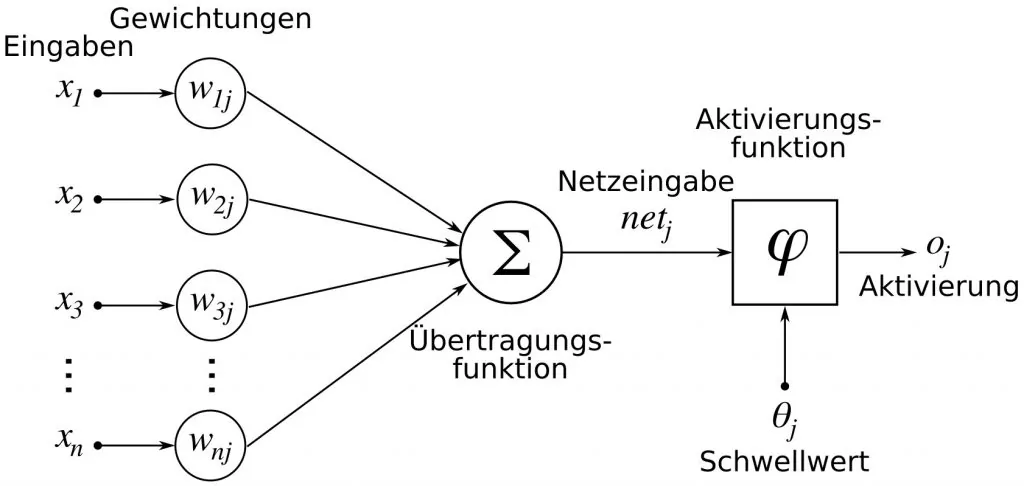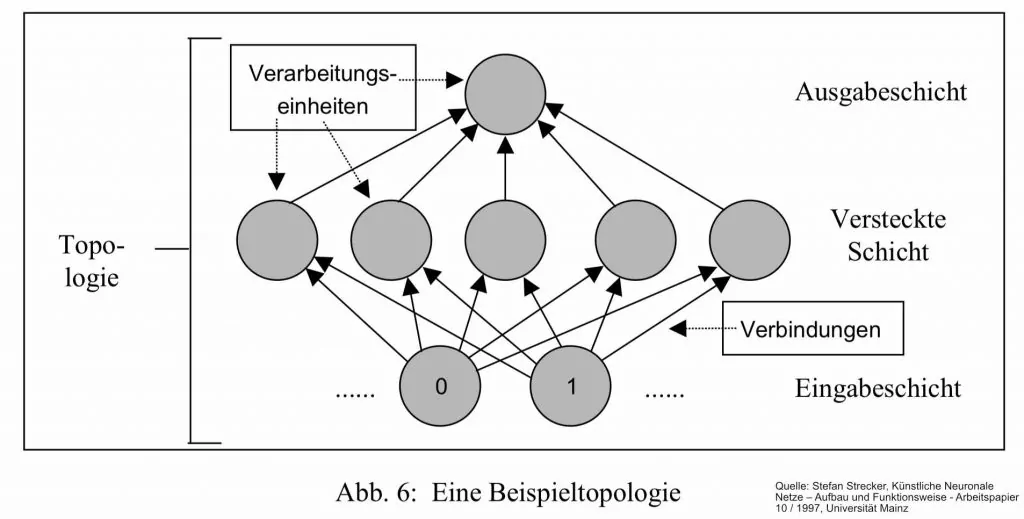Artificial intelligence (AI) can be defined as intelligence that originates exclusively from machines such as robots and cyber-physical systems. The field of AI research attempts to understand and replicate human perception and behavior. According to research, these are systems that approximate, mimic, replicate, automate, or even surpass and improve human thinking.
The field of AI research does not focus on a single, uniform technology. Rather, it involves interrelated technological elements (software and hardware) that can be used in a wide variety of ways depending on the problem at hand. In general, artificial intelligence consists of perceiving, processing, and learning elements; it can be divided into two sub-areas: machine learning and deep learning.
Application / Areas of application AI in general
There are numerous examples of practical applications in companies[1]
- Testing and assessment (pattern classification): creditworthiness checks, insolvency checks, image recognition
- Classification (clustering): market segmentation, data mining
- Forecasting (prediction): price forecasts, sales forecasts, cost forecasts
- Optimization: Transport optimization (traveling salesman problem), sequence planning
AI and the subfield of machine learning
Machine learning (ML) has nothing to do with artificial intelligence in the true sense of the word. Rather, ML relies on pattern recognition that can be performed by machines or computers. Instead of giving machines clearly defined rules to improve them (i.e., make them better at solving a task), they are supposed to learn (“independently”) from data. ML is thus the simplest and cheapest way to give computers a kind of “artificial” intelligence. In intralogistics, ML does not refer exclusively to machines, but rather describes a mode of operation that is also used in processes and algorithms.
Based on large amounts of data, known as training data, and algorithms, training phases are coordinated, which enable the software used to modify itself or learn new things. Classic examples of machine learning are the learning algorithms “Naive Bayes” and “Collaborative Filtering.” The latter is familiar from the online platform Amazon: “Customers who bought this item also bought.” The Naive Bayes method, on the other hand, is used in spam filters for email management. The real intelligence in machine learning systems is their ability to modify themselves as soon as more information or data becomes available. If an ML system has access to high-quality data (see also Smart Data), human intervention can even be dispensed with.
AI and the subfield of deep learning/neural networks
Deep learning is based on artificially generated neural networks, or ANNs for short.
In most applications, deep learning algorithms are based on the functioning of the human brain. ANN computing models, or rather the algorithms used, learn from experience like their human counterparts by individually adapting the simulated neural connections.
Structure of a neural network
The neurons of an artificial neural network are arranged in layers and are usually connected to each other in a fixed hierarchy. The neurons are mostly connected between two layers (inter-neuron layer connection), but in rare cases also within a layer (intra-neuron layer connection).

Image source: Chrislb / CC BY-SA 3.0
Editor’s note: The effectiveness of a neural network therefore lies in its interconnectedness. The layers mentioned above are linked to each other by individual neurons – in other words, each neuron in one layer is always connected to all neurons in the next layer. Individual pieces of information flow into the input layer, which in turn passes the information on to hidden layers; finally, the interpreted data is passed on via the output layer – the output of one neuron is the input of the next. When a neural network receives new data, these connections are strengthened or weakened; likewise, each connection in a neural network can be adjusted by assigning greater or lesser relevance to a feature.

Artificial neural networks generally have core components or basic building blocks that are found in all network types[2].
- Processing elements
- Connections between processing elements
- The network topology
The dynamic core components listed below describe the information processing that takes place within the ANN. The processing intervals are divided into the following phases.
- Learning phase
- Processing phase
AI: Elements of perception
Artificial intelligence must be able to absorb information in order to be able to understand or perceive the real world.
AI must therefore be able to process text, capture images and videos, record sounds, and also collect information about environmental conditions such as temperature, wind, and humidity. The Internet of Things (IoT) plays a major role in this context, as it involves collecting heterogeneous data from countless heterogeneous devices, drawing conclusions from it, and learning from it. a task that poses major challenges even for advanced data analysis tools today. In short, the IoT consists of all the information that is collected: Which devices are in use? How are these things connected? How is the data collected? What can be learned from this data? And, ultimately, what can be done differently as a result?
To ensure that information is recorded, AI systems generally require sensors that capture the outside world (see/hear/smell) so that they can then perform certain actions and activities. These sensors are installed in cameras, microphones, and within robotic systems, for example.
AI: Elements of data processing and learning
Training data forms the basis for the independent generation of knowledge and the accumulation of experience in AI systems; it is a prerequisite for all machine learning processes. Only with a sufficiently large data set can the system recognize patterns and regularities, which in turn enable it to solve new, previously unknown problems. Three types of training can be distinguished here:
- Supervised learning (Supervised Learning)
- Unsupervised learning
- Reinforcement learning
In supervised learning, all training data is labeled at the beginning – usually manually and with a great deal of effort – so that the corresponding solution is known in advance for each data point. The system then learns to correctly assign unknown data during the training phase. The quality of the ML system can be accurately evaluated because the solution is classified as clearly correct or clearly incorrect. Typical areas of application for supervised learning include solving classification and regression problems.
In unsupervised learning, on the other hand, no solution in the true sense is known at the outset. The main aim is to understand existing data in such a way that structures, patterns, and possible groupings are revealed. Since there is no clear solution (no rules are specified), it is not really possible to evaluate how successful the system has ultimately been. However, it is able to recognize connections that were not obvious before. Unsupervised learning is therefore particularly suitable for cluster analysis and formation, as well as for reducing the dimensions of large data sets in order to make complexity more manageable or to prepare for other algorithms.
Both training methods can also be used together, either sequentially or in combination.
Reinforcement learning is characterized by a trial-and-error strategy, which clearly distinguishes it from the other two training methods. As a rule, the system makes a series of decisions, but the results are only evaluated afterwards. It can be rewarded or punished for this; the permanent goal is to maximize rewards and minimize punishments. After some time, an optimal strategy develops as the system learns which decisions are rewarded in which situations. Reinforcement learning is typically used in the development of game strategies.
Examples of AI in operation
Service chatbots
In the future, artificial intelligence will replace humans in areas where computer-based services can deliver faster and higher-quality results to customers. Service chatbots, for example, make it easier for customers to find information and carry out simple transactions via voice or chat interfaces.
Machine learning algorithms scan a wide range of products and technical documentation and automatically respond to frequently asked questions. It should be noted that such systems focus exclusively on simple and basic questions.
In the future, users will increasingly turn to chatbots rather than websites to find relevant information.
Rudolf Grötz, Senior Technical Engineer at Raiffeisen Bank International – ix Magazine for Professional Information Technology / 06/2018, page 50 [3]
AI and logistics/intralogistics
The application of artificial intelligence is particularly suitable in the field of logistics and intralogistics – in almost all areas of the supply chain. In the logistics department of a company and within the logistics chain of all companies involved, vast amounts of data are generated every day, both structured and unstructured; artificial intelligence is predestined for exploiting this information. AI can help to develop new methods and behaviors, for example, by turning reactive processes into proactive ones, and by making concrete predictions instead of assumptions and rough estimates, thereby improving planning reliability. Of course, it is also possible to focus solely on existing processes and simply optimize manual and automated workflows in terms of time. In addition, services can be personalized and thus made more customer-friendly instead of following generic standards.
One example shows how striking the advantages of artificial intelligence can be in intralogistics: In one market, 7.5 percent of items are unavailable due to manual ordering and gaps on the shelves. The error rate drops to five percent when special AI software makes recommendations to a human dispatcher. If human corrections are dispensed with and artificial intelligence performs warehouse and logistics tasks completely autonomously, the error rate drops to 0.5 percent.
Joachim Bengelsdorf / diyonline magazine[4]
Logistics examples: Artificial intelligence
Warehouse logistics is considered the first area of application for widely used artificial intelligence. This is also referred to as the learning warehouse. Algorithms already analyze large amounts of information there today.
- This is preceded by AI being able to predict certain events (via e-commerce, multi-channel, cross-channel) with near accuracy. By analyzing ordering behavior in greater depth, for example, reliable statements (and thus measures) can be made regarding future orders, also to enable a faster shipping process. It is important to note that processes within a warehouse are automated so that the respective procedures, whether goods receipt, storage, retrieval/transfer, picking, finishing, or goods issue, are clearly defined in terms of time; this means that reliable statements based on intralogistics are always possible.
- It is also common practice to identify trend items at a specific point in time. The responsible employees can then adjust the product allocation in the warehouse as needed in order to optimize routes during order picking, similar to the principle of fast and slow movers.
- Upcoming maintenance or potential improvements in the material flow can also be identified in this way. This represents a significant step toward cognitive logistics, which is the ultimate goal within the supply chain in terms of reducing the error rate. With the help of the necessary semantics, objects can not only be linked in a way that machines can understand, but employees and senior management can also navigate in real time from a pick (e.g., pick-by-MDE) to the order or to the original notification in goods receipt in order to draw relevant conclusions. The semantic analysis of logistics processes in particular is a special method of information gathering that generally allows the interpretation of key figures and delivers accurate results thanks to the inclusion of domain knowledge (synonyms, similarities, ontologies, and taxonomies). In the future, it is conceivable that intelligent systems will make decisions based on predictive analytics, completely without human intervention.
- Also worth mentioning: Optimizing the collaboration between humans and robots (human-machine interface) is another practical application for artificial intelligence, namely by enabling robots to learn from humans. Virtual reality and 3D modulation enable humans to automatically generate digital information. A special hand movement for grasping a single position is one example of this. The movement can be measured with millimeter precision, thereby improving the gripping of robots within the picking process (pick-by-robot).
Artificial intelligence makes the warehouse of the future more dynamic, more agile, and more responsive. The intelligent networking of machine, process, and product information is a quantum leap for process optimization.
Tim Eick, Head SynQ Competence Center, Swisslog Logistics Automation
Summary Artificial intelligence
From route optimization and inventory management to batch formation and the resulting synergy effects in order scheduling, artificial intelligence and its algorithms are already supporting warehouse employees through targeted process optimization (see also Control center in intralogistics). In the future, so-called cognitive systems will have the ability to learn, recognize patterns, and derive recommendations for action—without being dependent on human cognitive abilities. This will enable them to support warehouse employees in their decision-making or alert them in advance to events that are likely to occur.
Further links:
Sources:
[3] ix Magazine for Professional Information Technology / 06/2018, page 50
[4] diyonline.de / AI as an opportunity for intralogistics
If you are interested in automation, then read the articles Computer-integrated manufacturing and Smart Factory / the intelligent factory.
